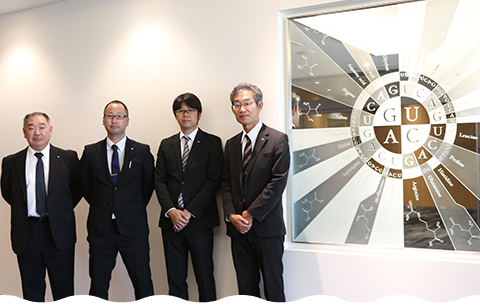
 〈 Art monument at the entrance of the Institute of Environmental Ecology 〉
〈 Art monument at the entrance of the Institute of Environmental Ecology 〉
A. The Institute of Environmental Ecology provides comprehensive consulting services for the formation of social infrastructure and environmental conservation. It was established in 1992 in the town of Oigawa (now Yaizu City), Shizuoka Prefecture, as a core laboratory responsible for developing technologies relating to IDEA’s surveys and research in the fields of biology and chemistry. Notable features of the Institute include its breeding and experimental facilities, which have abundant access to seawater from Suruga Bay and subterranean groundwater from the Ooi River. We make the best use of these features to actively engage in various biological experiments, develop technologies for environmental risk analyses and assessments, as well as to develop and practically apply new technologies and equipment aimed at mitigating environmental impacts. In recent years, we have been facing environmental issues that need to be addressed on a global scale, such as global warming, persistent organic pollutants (POPs), and mercury emissions. At the Institute, we conduct research and develop technologies to address issues such as the ecological and human health effects of hazardous chemical substances released into the environment, in a way that organically links together the fields of ecosystems & biodiversity, environmental chemistry, and environmental risks. In the spring of 2023 as part of our 70th anniversary project, we constructed the Life Science and Advanced Informatics Research Center within the Institute of Environmental Ecology to serve as a hub for technological development in the life sciences, in order to meet the social needs of the new era. The Center focuses on advancing environmental DNA analysis technologies, putting microRNA and other new genetic analysis technologies into practical use in society, and assessing the risks of chemical substances in relation to human health, while also creating new businesses and developing new markets within the scope of the life sciences.
 〈 Art monument at the entrance of the Institute of Environmental Ecology 〉
〈 Art monument at the entrance of the Institute of Environmental Ecology 〉
A. Each department at the Institute is involved in different projects. For example, the Environmental Biology Department primarily conducts biological analyses for public works construction projects and national census surveys at the request of the Ministry of Land, Infrastructure, Transport and Tourism and the Ministry of the Environment. Recently, we have also been involved a marine development project run by the national government, and have been conducting environmental surveys on behalf of the Ministry of Economy, Trade and Industry and related independent administrative agencies. On the other hand, the Environmental Chemistry Department has been conducting surveys for more than ten years for the Japan Environment and Children’s Study (JECS), run by the Ministry of the Environment, collecting biological samples from pregnant mothers to determine the impact of chemical substances on the growth and health of children. This study, involving 100,000 mother-child pairs, investigates how mothers are exposed to chemical substances in their surroundings and how their unborn children are affected. The Institute is responsible for analyzing blood and urine, among other tasks. Research on environmental conservation and human health is progressing through efforts like these, and each technical department contributes to society in a different field.
A. At the Institute, technicians specialized in ecosystems & biodiversity, environmental chemistry, and environmental risk conduct surveys and research, and develop technologies. In particular, in the field of ecosystems & biodiversity, we conduct species assessments and quantifications of aquatic organisms, biological experiments, and on-site ecosystem surveys in order to aid in assessing the environmental impact of various business activities. In addition, in recent years, we have also been focusing on surveys and research that make use of genetic analysis technologies. Environmental DNA analysis, incorporated as method of research and analysis in the Okinotorishima Islands survey, enables efficient and comprehensive monitoring of the diverse array of marine organisms that inhabit aquatic environments. It is also useful in investigating deep-sea ecosystems when establishing marine sanctuaries as well as when assessing the environmental impact of future marine resource development. In addition to environmental DNA analysis, we are also involved in environmental research and ecosystem conservation activities that make use of high-resolution images of the seafloor viewed, photographed, and recorded using autonomous underwater vehicles (AUVs).
A. The term environmental DNA refers to DNA of biological origin that exists in the environment, such as in water sources, in soil, and in the atmosphere. Analyzing environmental DNA enables us to detect DNA contained in water and soil samples collected at survey sites, to compare the results with sequences in a DNA database to deduce the species that inhabit the survey site, and to make comparisons between survey sites of the relative amounts of biomass of the species being studied by comparing the amounts of specific DNA sequences detected.
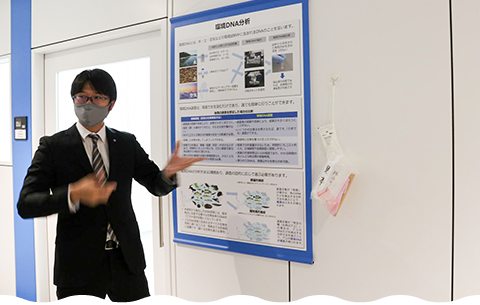 〈 Senior Researcher Shirako giving an explanation in front of an informational poster on environmental DNA analysis 〉
〈 Senior Researcher Shirako giving an explanation in front of an informational poster on environmental DNA analysis 〉
A. Unlike conventional capture surveys and other methods, surveys that make use of environmental DNA analysis are far easier to perform in the field because all you have to do is draw water. This greatly reduces the time and labor required to conduct surveys. Another advantage is that it is possible to survey wide areas in a short period of time. Another problem with capture surveys is bycatch, the accidental capture of rare or otherwise untargeted species. With environmental DNA surveys, however, there is no need to worry about damaging organisms or ecosystems because all you are doing is drawing water. In addition, it is extremely difficult to capture deep-sea organisms, so environmental DNA analysis is particularly effective when surveying deep-sea organisms because it enables surveys to be conducted without the need for capture.
A. Basically, all we do in the field is collect water samples. Usually, all we do is draw water into collection containers and ship it to the analysis facility. That’s the end of our duties in the field. However, since the open-sea surveys around Okinotorishima Islands are conducted over long periods of time using research ships, it is not possible to immediately send the collected water samples to the analysis facility, so it is necessary to filter the water and conduct other pretreatment processes on board the ship. This is because environmental DNA degrades over time after the water has been collected, and the water samples would not otherwise last until the end of the survey. Therefore, during the open-sea surveys around Okinotorishima Islands, we prevent DNA degradation by filtering the water collected on board, catching the environmental DNA in filters, and freezing it for storage. The main thing to be careful of during these operations is contamination. If the samples become contaminated with DNA from food on board the research vessel, then species (contamination) that do not actually inhabit the area may be erroneously identified. When analyzing environmental DNA, since the miniscule amounts of DNA contained in the water samples are detected with a high degree of sensitivity, we pay careful attention to prevent contamination by limiting fish served in meals during survey voyages, and by ensuring that the researchers in charge of collecting samples, and thereby coming into direct contact with the organisms, are not the same researchers who conduct the filtration process.
 〈 Senior Researcher Shirako giving an explanation in front of an informational poster on environmental DNA analysis 〉
〈 Senior Researcher Shirako giving an explanation in front of an informational poster on environmental DNA analysis 〉
A. Let me give you an example of what happens from the DNA extraction process onward, once the filtration process has been completed in the field. Since the DNA gets caught by the filters, we use a kit to extract it. The DNA is too sparce to detect it in that state, so next, we need to amplify it. To do this, we use a technique called polymerase chain reaction (PCR). PCR is a means of amplifying DNA, but it is also used in coronavirus testing because it is possible to specify which DNA gets amplified. Once the DNA is amplified, we clean it by removing any excess material. Then, we scan the DNA sequence using a device called a next-generation sequencer. This enables us to examine each type of DNA individually, even if various types are adhered to the filter paper. Finally, we compile a list of the DNA detected, and identify to which organisms the DNA in the samples belong by cross-checking them against an international DNA database. When performing these operations, it is important to prevent contamination, the same as in field work.
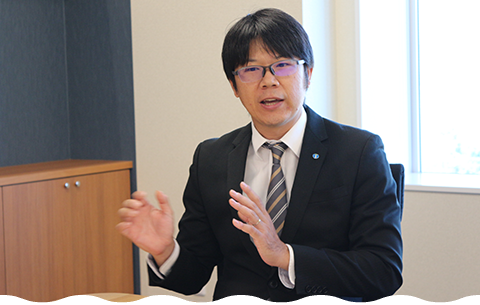
A. As in field work, the hardest part is preventing contamination. We perform environmental DNA analysis with the utmost care because contamination will produce erroneous results. These analyses involve handling DNA that is even more concentrated than when in the field, so it is extremely important to prevent contamination between individual DNA samples. We take various measures, such as conducting each step in the sample treatment process in a different room, and ensuring that laboratory desks and instruments are decontaminated both before and after experiments. Since contamination occurring in the course of conducting environmental DNA analysis cannot be detected by the naked eye, we take every conceivable precaution and maintain constant vigilance during the entire process from surveys through to the analyses. A high degree of expertise is also essential for environmental DNA analysis, as the process requires highly sensitive instruments and knowledge of how to use them. Skills and experience are required to operate the experiments and analyze the data. Environmental DNA analysis is a relatively new technology, and one challenge is that standardized protocols and guidelines have yet to be put in place. It is necessary for researchers to constantly share information and work to improve the analytical and investigative techniques.
 〈 Senior Researcher Shirako in a conference room at the Institute of Environmental Ecology 〉
〈 Senior Researcher Shirako in a conference room at the Institute of Environmental Ecology 〉A. We infer the species by comparing the DNA sequence detected with the DNA sequences registered in the databases. However, if the DNA sequence is not registered in the databases, then it is impossible to infer the species. For example, most species of freshwater are registered in the international DNA database, but not all deep-sea fish species––the subject of the Okinotorishima Islands survey––have been registered. And even fewer crustaceans have been registered. If it is difficult to find a match in the DNA databases, then we have to observe the organism’s morphology to make a determination.
A. For fish in Japanese waters, almost all freshwater fish species––other than the very rare ones––have been registered. However, the databases do not yet cover diversity within a species due to the presence of region-specific and unique types of DNA. Even fewer saltwater fish species have been registered. Only about 60 to 70% of aquatic plants are in the databases, and the percentage is likely far lower for deep-sea organisms. We believe that it is important to enhance DNA databases, and we strive to register as much data as possible through our research. The databases we use are the National Center of Biotechnology Information (NCBI) and DNA Data Bank of Japan (DDBJ). These systems are designed so that data can be registered simply by submitting it in accordance with the rules. However, since anyone can register data, not all of the data posted is actually accurate. The easier it is for anyone to register data, the more necessary it is to be able to correctly assess it.
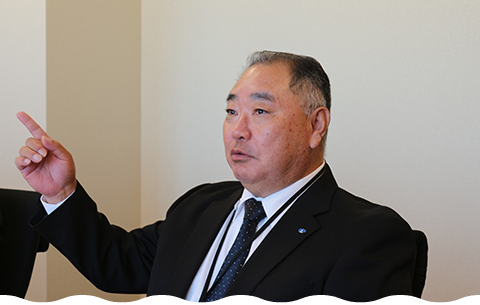
A. If the international DNA database improves, we should be able to identify most species. However, for very closely related species, the portion of the DNA sequence scanned may be exactly the same, making it impossible to distinguish between them. For example, many species such as the true tunas (Thunnus spp.) or the Japanese red seaperch (Sebastes spp.) seem to have the same sequences when looking only at the short sequences often used in environmental DNA analysis, preventing us from telling them apart. Since it would not be possible to identify these species even if the database were to improve, it is necessary to take measures such as reading other parts of the DNA sequence. DNA sequences may also vary by region, even within the same species. DNA databases need more than a single set of data for each species. Improving DNA databases is no easy task, as it is necessary for the data to cover the diversity within a species in different regions. However, it is extremely important that we improve them in order to improve analytical accuracy.
 〈 Deputy Director Sato in a conference room at the Institute of Environmental Ecology 〉
〈 Deputy Director Sato in a conference room at the Institute of Environmental Ecology 〉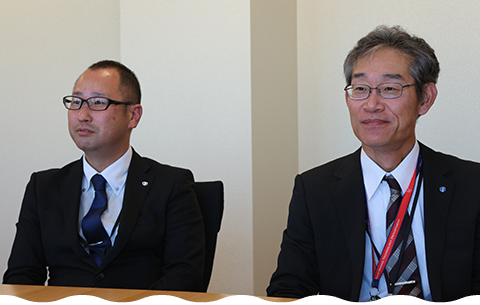
A. Among the general public, there are many people who––while not necessarily researchers––are very knowledgeable about or fond of living organisms. If people like that would inform us when they find an interesting organism, it would help in increasing the volume of information in databases. Recently, in a field known as “citizen science,” we have been working with university professors to encourage people to conduct environmental DNA analyses. For example, events are held at Lake Biwa where citizens can participate in surveys all together and analyze the collected data with university professors. Since participants are also able to experience DNA analyses, it may be necessary to increase the number of people who become interested in and knowledgeable about the subject through participation in such events.
 〈 From left to right: Senior Researcher Yokooka and General Manager Sugishima in a conference room at the Institute of Environmental Ecology 〉
〈 From left to right: Senior Researcher Yokooka and General Manager Sugishima in a conference room at the Institute of Environmental Ecology 〉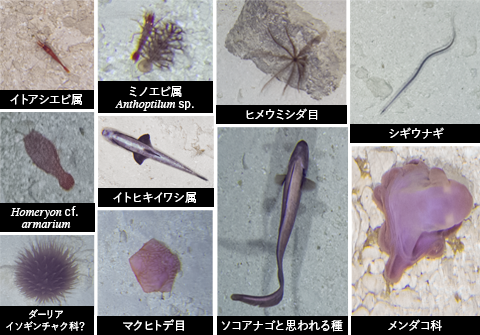
A. When conducting a biota survey using an AUV, we preprogram the dive route in the our AUV (named YOUZAN), and then simply drop it into the ocean to let it follow the designated route on its own. The AUV is able to continuously capture images from directly above the surface of the seafloor without any gaps. In surveys conducted in 2022, we acquired approximately 4,000 images per dive. We are now working to identify the types and numbers of deep-sea animals recorded in each image of the seafloor obtained using the AUV (YOUZAN). Since our knowledge of deep-sea animals is still limited, in this research project, we work with some researchers of marine animal taxonomy in order to determine the types of animals.
 〈 Photographs of (some of the) organisms identified while surveying Okinotorishima Islands in 2022 〉
〈 Photographs of (some of the) organisms identified while surveying Okinotorishima Islands in 2022 〉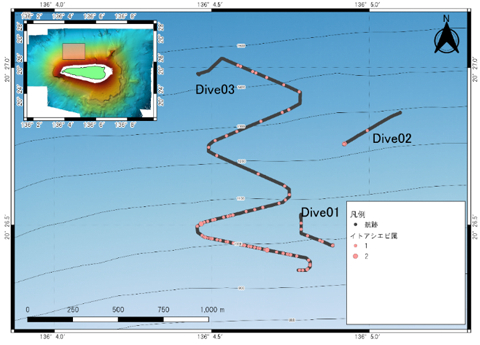
We will continue to count how many of which animals are in each image, reflecting the opinions of experts. The images obtained using the AUV (YOUZAN) contain latitude and longitude information, and by overlaying this data on a seafloor topographic map using geographic information software (GIS), it is possible to determine the distribution status of each animal. This is called a habitat map. In the future, we plan to integrate all of the survey results from 2022 and 2023 in order to compare fish species that have been studied in previous research projects and clarify the characteristics of the biota around Okinotorishima Islands.
 〈 Habitat map of the Nematocarcinus sp. 〉
〈 Habitat map of the Nematocarcinus sp. 〉A. We have been using research ships to continuously conduct comprehensive scientific surveys of marine geology and marine ecosystems in the Okinotorishima Islands area. We believe that clarifying the origins of Okinotorishima Islands, which is under the jurisdiction of the Tokyo Metropolitan Government, as well as the state of biodiversity in the area from the surface all the way to the deep-sea layer, will aid in making use of and preserving the island in the future. While Okinotorishima Islands and Minamitorishima Island are not easy to visit, we hope that the findings of this research project increase interest in these islands among the citizens of Tokyo. The results of this scientific research project will be presented to the citizens of Tokyo at symposiums and other events hosted by the Tokyo Metropolitan Government, so please look forward to them.